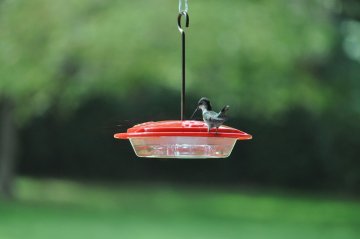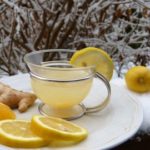Most people love to see the iridescent flutter of tiny wings in their back yards–humming birds. They purchase a hummingbird feeder, fill it as directed and wait for the beautiful little birds to appear. Unfortunately, they may have a long wait. Nectar is not the only thing you need to attract hummingbirds to your feeder.

A hummingbird visits a backyard feeder.
A variety of flowers can be planted that are favorite food of hummingbirds. They not only provide a preferred meal, but are colored to signal to the birds, and send out a light scent on the breeze that draws them in. Firecracker Penstemon is one of these. It shoots up several stems about 3 ft. and then produces vibrant red flowers. It grows well even in dryer soils, providing an eye-catching addition to your garden along your fence or border.
Planting a “hummingbird garden” provides the birds with a natural diet, attracting them to your feeder. Hummingbirds feed by sight along the same route–a grazing method called trap-lining. They are instinctively curious which quickly leads them to new sources of food. A hummingbird garden is a fantastic way to get photos or video of your local hummingbirds. Although you may enjoy the birds close-up at your feeder, a floral venue provides a beautiful background for your pictures (prettier than your feeder.)
A planned hummingbird garden consists of a variety of plants, carefully chosen to flower throughout the season. They will keep your yard on the hummingbirds’ buffet route all year. Besides choosing the right flowering plants to make your yard desirable, you need to keep pesticides away from your flowers. Hummingbirds also rely on the small insects as a source of protein in their diets. These are what pesticides are meant to kill . The birds can also ingest the pesticides which may make them sick and even kill them.
Hummingbirds prefer a floral kaleidoscope since the plants they like have very little fragrance. So make sure that the plants you choose provide a variety of bright colors. Your local nursery will be able to help you choose the best flowers for your area. Some of the best choices (depending on where you live) are:
- Azalea
- Butterfly Bush (Buddleia)
- Cape Honeysuckle
- Flame Acanthus
- Flowering Quince
- Lantana
- Manzanita
- Mimosa
- Red Buckeye
- Tree Tobacco
- Turk’s Cap
- Weigela
Vines may also produce flowers that will draw hummingbirds to your yard and feeder. Some of the best choices are Coral Honeysuckle, Cypress Vine, Morning Glory, Scarlet Runner Bean, and Trumpet Creeper.
Between forays to feed, hummingbirds also need convenient places to perch. Providing plants in your yard that make good perches will improve your popularity with the hummingbird crowd.
Using red or orange fluorescent surveyor’s tape to decorate your feeder, tastefully, may also increase the number of hummingbirds you get to feed. They are sensitive to ultraviolet light, and these fluorescent tapes reflect that light wavelength. Ornithologists suggest that every year there isn’t one square meter of the U.S. or Canada that hasn’t had a hummingbird check it out in a search for food. So your enhanced feeder is sure to be found by some of them. Improving the likelihood that they will find the feeder is done by widening out the feeding area to include your whole yard.
Now that you have your yard prepared to entice hummingbirds to your area, you need to think about your feeder. You can’t just fill it and expect the birds to keep coming. Feeders need the proper care to continue to be attractive to the hummingbirds. The feeder needs to be cleaned regularly, and the nectar refilled every 3-4 days (more often during the summer heat.) If you ever see black spots inside your feeder, it‘s mold. This must be scrubbed out if you want to keep the birds coming.
When the mold is in a place you can’t reach with a bottle brush, add some sand and water to the feeder and shake it vigorously to remove the mold. You should never use detergent to clean your feeder, but do rinse it thoroughly with hot water every time you change your nectar. Only fill the feeder half full. Then you will not be throwing out a lot of nectar every time you need to clean and refill. These measures will also keep it from getting moldy before you need to change the nectar again.
Making these adjustments in your backyard area will make it a hummingbird haven for you to enjoy during the coming years.




